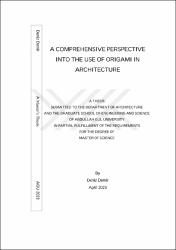| dc.contributor.author | Demir, Deniz | |
| dc.date.accessioned | 2024-01-08T08:47:57Z | |
| dc.date.available | 2024-01-08T08:47:57Z | |
| dc.date.issued | 2023 | en_US |
| dc.date.submitted | 2023-04-10 | |
| dc.identifier.uri | http://acikerisim.agu.edu.tr/xmlui/bitstream/item/ba348402-2c09-4bb1-ace2-4efcf226693d/806169.pdf?sequence=1&isAllowed=y | |
| dc.identifier.uri | https://hdl.handle.net/20.500.12573/1878 | |
| dc.description.abstract | In today's conditions, in the production methods used by different disciplines, functionality is sought as well as aesthetics, and design decisions are taken at the beginning of the process by considering the functional properties that the product should have. There is a similar situation in architecture, and it is expected that the methods used in finding form will bring other features. There is a need for methods to achieve maximum efficiency in the construction process, which is created by considering environmental performance, cost, aesthetics, and benefits to the user. One of these methods is origami, known as the art of paper folding, and is used as a design technique for architectural design in different countries around the world. The origami technique, which is basically used to obtain three-dimensional objects from two-dimensional paper, is used in architecture to create volumes and surfaces with a similar logic. In the built examples, it is seen that this technique is used to design and construct the building component, building element, or the whole building. While there are projects where this technique is used for form finding, features such as foldability and deployability from origami are used in projects which require different functions. Within the scope of this thesis, a comprehensive perspective is proposed to this technique, which is used for different purposes and at various scales. In this context, it has been seen that there is a relationship between morphology, building performance, and origami pattern characteristics. This connection between them is effective in using origami as a design technique in architecture. This systematic data set was analyzed and the parameters are defined with this approach. The survey method was used to obtain information about the perspectives of the designers who were inspired by origami while designing their projects. It is aimed to collect data on the use of origami in architecture and the relationship between morphology, building performance, and pattern characteristics stated in the thesis. In this way, it is aimed to reach the participants' perspectives, which they have gained through experience, by asking questions related to the proposed perspective. The answers obtained were analyzed and contributed to the comprehensive perspective proposal in the thesis. | en_US |
| dc.description.abstract | Günümüzde, farklı disiplinler tarafından kullanılan üretim yöntemlerinde estetik kadar işlevsellik de aranmakta ve sürecin başında ürünün sahip olması gereken fonksiyonel özellikler göz önünde bulundurularak tasarım kararları alınmaktadır. Mimari tasarımda da aynı durum geçerlidir ve form bulmada kullanılan yöntemlerin, başka özellikleri de beraberinde getirmesi beklenmektedir. Çevresel performans, maliyet, estetik ve kullanıcı gereksinimleri dikkate alınarak başlayan tasarım sürecinde maksimum verim elde edilecek yöntemler aranmaktadır. Bu yöntemlerden biri kağıt katlama sanatı olarak bilinen origamidir ve dünyanın farklı ülkelerinde mimarlık ofisleri tarafından bir tasarım tekniği olarak kullanılmaktadır. Temel mantığı iki boyutlu kağıttan üç boyutlu nesneler elde etmek olan origami tekniği, mimaride de benzer mantıkla hacimler ve yüzeyler oluşturmada kullanılmaktadır. Yapılı örneklerde bu tekniğin bina bileşenini, bina elemanını ya da binanın kendisinin tasarımında kullanıldığı görülmektedir. Form bulmada bu tekniğin kullanıldığı projeler olduğu gibi, doğrudan fonksiyon odaklı olan projelerde origamiden gelen katlanabilirlik ve konuşlandırılabilirlik gibi özelliklerden faydalanılmaktadır. Bu tez kapsamında farklı amaçlar için ve çeşitli ölçeklerde kullanılan bu tekniğe kapsamlı bir bakış açısı önerilmektedir. Bu bağlamda yapılan literatür taramasında morfoloji, bina performansı ve origami desen özellikleri arasında ilişki ve aralarındaki bu bağlantı, origaminin mimaride bir tasarım ve yapım tekniği olarak kullanılmasında etkili olduğu görülmüştür. Oluşturulan bu sistematik veri seti analiz edilerek yapılı örnekler de bu yaklaşımla incelenmiştir ve bu örnekleri tasarlarken ya da yaparken origamiden etkilenen tasarımcıların bakış açılarına dair bilgi elde etmek için anket yöntemi kullanılmıştır. Anket soruları temelde origaminin mimaride kullanımıyla ve tezde oluşturulan morfoloji, bina performansı ve desen karakteristiği ilişkisiyle ilgili veriler toplamaya yöneliktir. Bu yolla, önerilen perpektifle bağlantılı sorular sorularak katılımcıların tecrübe ile edindikleri kendi bakış açılarına ulaşılması hedeflenmiştir. Elde edilen ceveplar analiz edilerek tezde önerilen kapsamlı bakış açısına katkı sağlamıştır. | en_US |
| dc.language.iso | eng | en_US |
| dc.publisher | Abdullah Gül Üniversitesi, Fen Bilimleri Enstitüsü | en_US |
| dc.rights | info:eu-repo/semantics/openAccess | en_US |
| dc.subject | Origami | en_US |
| dc.subject | Origami Architecture | en_US |
| dc.subject | Pattern Behavior | en_US |
| dc.subject | Morphology | en_US |
| dc.subject | Building Performance | en_US |
| dc.subject | Mimarlıkta Origami | en_US |
| dc.subject | Desen Davranışı | en_US |
| dc.subject | Morfoloji | en_US |
| dc.subject | Bina Performansı | en_US |
| dc.title | A comprehensive perspective into the use of origami in architecture | en_US |
| dc.title.alternative | Origamı'nin mimarlıkta kullanılmasına kapsamlı bir bakış açısı | en_US |
| dc.type | masterThesis | en_US |
| dc.contributor.department | AGÜ, Fen Bilimleri Enstitüsü, Mimarlık Ana Bilim Dalı | en_US |
| dc.relation.publicationcategory | Tez | en_US |


















